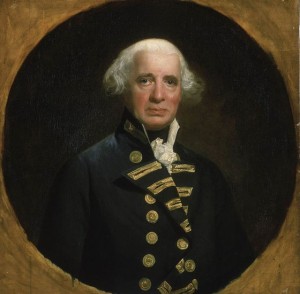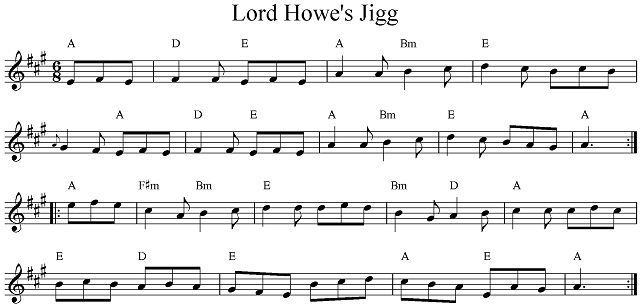Lord Richard Howe (1726-99) was one of the most celebrated naval heroes of the period and First Lord of the Admiralty from 1783 to 1788. Renowned for bravery and integrity, he served during the American War of Independence and the French Revolutionary War; his most famous the victory the “Glorious First of June’ 1793. With diplomacy, he resolved the Great Mutiny in 1797 and sailors fondly called him “Black Dick,” because of his dark, weather-beaten face.
As a young man he served under Admiral Boscawen where dancing to the fiddle, fife and drum were almost daily occurrences, providing a source of entertainment and exercise for the seamen, and helping to maintain a connection with home.
In 1788, Lieutenant Ball, commander of the frigate Supply, one of the ships in the First Fleet, discovered an island, naming it Lord Howe Island “in honour of The Present first Lord of the Admiralty.” Several years earlier on 20 April 1770, Captain James Cook had the named of the coastal headland [on the border between New South Wales and Victoria], Cape Howe for Richard, 1st Earl Howe who was Treasurer of the Navy at that time.
Lord Howe was instrumental in the decision to found the colony, was personally acquainted with a number of the leading figures in early Sydney society, including Governor Bligh and Matthew Flinders, and was a close friend of Governor Hunter. One of Lord Howe’s close relatives, John Howe, had served with this uncle against the French before settling in the colony’s Hawkesbury area in 1801.
Reflecting this great popularity, a number of dances were composed in England, bearing his name: Commodore Howe’s Ramble, Lord Howe’s Fleet, Lord Howe’s Hornpipe, Lord Howe’s Jig, Lord Howe’s Minuet, Success to Lord Howe.
Arr. Roland Clarke
Country dance: triple minor longways
| A1 | 1 – 8 | Hey on own side. [skip change of step] |
| A2 | 1 – 8 | Circle six-hands round and back. [slip steps] |
| B1 | 1 – 4 | All set and change places with partners. |
| B1 | 5 – 8 | All set and change places. |
| B2 | 1 – 4 | 1st couple cross, cast and turn to own side. |
| B2 | 5 – 8 | 1st corners change, 2nd corners change. Repeat. |
Thompson’s Twenty four Country Dances for the Year 1777 “as they are performed at Court, Bath, and all Publick Assemblys.”
__________________________________________________________________________
Sources
Australia’s Heritage. The Making of a Nation. Vol.1 Landsdown Press, Sydney 1988.
Dando-Collins, Stephen. Captain Bligh’s Other Mutiny. Random House, Sydney, 2007.
Fowell, Newton. The Sirius Letters. The Complete Letters of Newton Fowell. 1786-1790. Midshipman & Lieutenant aboard the Sirius, Flagship of the First Fleet on its voyage to New South Wales. Ed. Nance Irvine. Fairfax Library, Sydney, 1988.
Hardy, Bobbie. Early Hawkesbury Settlers. Kangaroo Press, Kenthurst, 1985.
Keller, Kitty van Winkle & Hendrickson, Charles Cyril. George Washington. A Biography in Social Dance. Hendrickson Group, Connecticut, 1998.
Phillip, Arthur. The Voyage of Governor Phillip to Botany Bay. Angus and Robertson in association with the Royal Australian Historical Society, 1970.
__________________________________________________________________
The information on this website www.historicaldance.au may be copied for personal use only, and must be acknowledged as from this website. It may not be reproduced for publication without prior permission from Heather Clarke.



